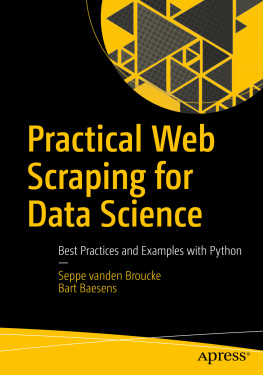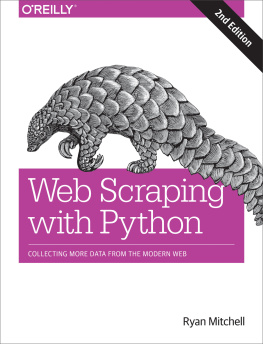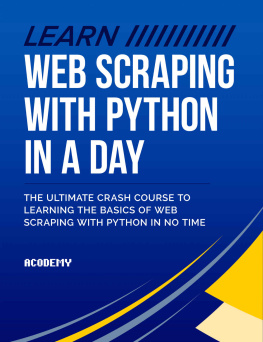Seppe vanden Broucke - Practical Web Scraping for Data Science: Best Practices and Examples with Python
Here you can read online Seppe vanden Broucke - Practical Web Scraping for Data Science: Best Practices and Examples with Python full text of the book (entire story) in english for free. Download pdf and epub, get meaning, cover and reviews about this ebook. year: 2018, publisher: Apress, genre: Home and family. Description of the work, (preface) as well as reviews are available. Best literature library LitArk.com created for fans of good reading and offers a wide selection of genres:
Romance novel
Science fiction
Adventure
Detective
Science
History
Home and family
Prose
Art
Politics
Computer
Non-fiction
Religion
Business
Children
Humor
Choose a favorite category and find really read worthwhile books. Enjoy immersion in the world of imagination, feel the emotions of the characters or learn something new for yourself, make an fascinating discovery.
- Book:Practical Web Scraping for Data Science: Best Practices and Examples with Python
- Author:
- Publisher:Apress
- Genre:
- Year:2018
- Rating:5 / 5
- Favourites:Add to favourites
- Your mark:
Practical Web Scraping for Data Science: Best Practices and Examples with Python: summary, description and annotation
We offer to read an annotation, description, summary or preface (depends on what the author of the book "Practical Web Scraping for Data Science: Best Practices and Examples with Python" wrote himself). If you haven't found the necessary information about the book — write in the comments, we will try to find it.
This book provides a complete and modern guide to web scraping, using Python as the programming language, without glossing over important details or best practices. Written with a data science audience in mind, the book explores both scraping and the larger context of web technologies in which it operates, to ensure full understanding. The authors recommend web scraping as a powerful tool for any data scientists arsenal, as many data science projects start by obtaining an appropriate data set.
Starting with a brief overview on scraping and real-life use cases, the authors explore the core concepts of HTTP, HTML, and CSS to provide a solid foundation. Along with a quick Python primer, they cover Selenium for JavaScript-heavy sites, and web crawling in detail. The book finishes with a recap of best practices and a collection of examples that bring together everything youve learned and illustrate various data science use cases.What Youll Learn
- Leverage well-established best practices and commonly-used Python packages
- Handle todays web, including JavaScript, cookies, and common web scraping mitigation techniques
- Understand the managerial and legal concerns regarding web scraping
A data science oriented audience that is probably already familiar with Python or another programming language or analytical toolkit (R, SAS, SPSS, etc). Students or instructors in university courses may also benefit. Readers unfamiliar with Python will appreciate a quick Python primer in chapter 1 to catch up with the basics and provide pointers to other guides as well.
Seppe vanden Broucke: author's other books
Who wrote Practical Web Scraping for Data Science: Best Practices and Examples with Python? Find out the surname, the name of the author of the book and a list of all author's works by series.









